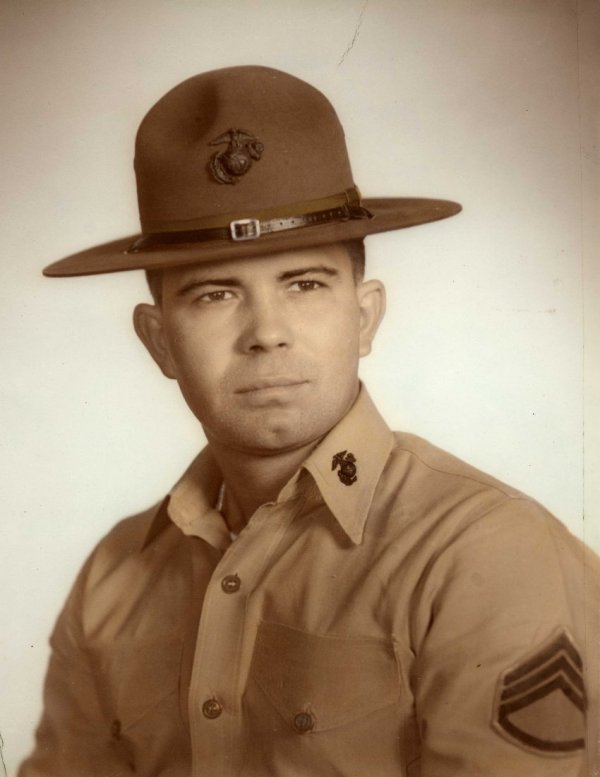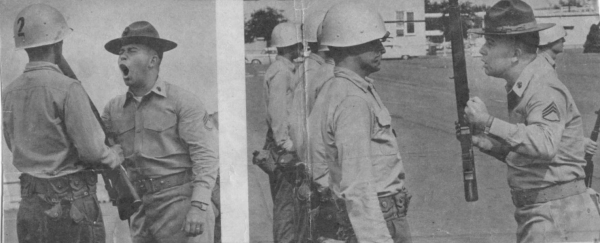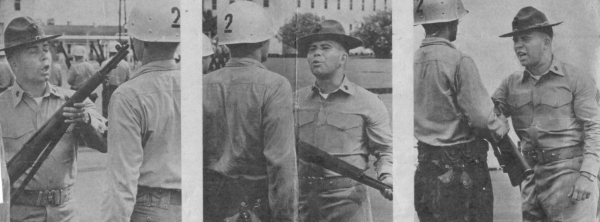|
by Major Courtney B. Payne USMC (Ret.)
January, 2007. As I stood in a cold light rain looking at the World War I statue of Iron Mike at Parris Island a few weeks back, I had time to reflect on an often asked question, where had all the years gone? That day was my 50th Anniversary. Fifty years, half a century since reporting in for Drill Instructors School. Little did I realize how being at Parris Island that cold January morning in 1957 would change my life forever. Drill Instructors School and Recruit Training had changed over the past eight months before my arrival. Because of a terrible incident, which cost the lives of six recruits in the spring of 1956, Brigadier General Wallace Green was on board to put his leadership and common-sense talents to work. He would, while I was there, alleviate problems confronting the much maligned Drill Instructors and Marine Recruit Training. Some years later he would be our Commandant. My entrance in to Drill Instructor’s School was a shock to say the least! As I walked down a passageway that January day I glanced into a head and there, on their knees, cleaning a urinal, was a Gy/Sgt. and a S/Sgt. Needless to say I felt I had made a mistake of monumental proportions! I was a junior S/Sgt. and knew my place on the totem pole in this class would be in the basement. Early in 1957 D.I. School was located in the old Depot Hospital, a white frame building located near the river. Our instructors were the finest. They were fair, sharp, and knew their business but they were tough and had a serious and difficult job. You could quit anytime you wanted, me, I was indestructible and just twenty-three years old, in good shape and single; I figured school would be a snap. Ha! Another mistake! Not only did they whip my butt into shape, they caused my thinking to change. I had never thought beyond my present enlistment, while I “liked” the Marine Corps, it was a rather shallow affection at that. Serving with other D.I.’s from different commands I had my eyes opened. Working with these men who ”lived” the dedication and gave meaning to that word, pro- vided me with examples of leadership not yet seen, and, what it is to be a Marine. The two years at Parris Island passed quickly. First as a Junior D.I., then, as a Senior I graduated platoons I was proud of. When a parent of a recruit sincerely thanked you for the job you had done with their son, you knew it was you, but, it was also the Marine Corps Training that made that young man in to something positive the parent sometimes had a hard time recognizing. During October, 1957 I was married at the “new” Depot Chapel. A couple of years ago I visited the Island with my wife and we made arrangements to renew our wedding vows at the same chapel. I was amused to find it’s now referred to as the “old” Depot Chapel. I had asked my Company Comman- der and Battalion Commander for permission to get married. The Battalion Sergeant Major let me know I did the correct thing. He also told me things would be tight financially, and to be frugal. Boy! Was he right! Promotions followed, but slowly. It was along dry spell after the Korean War. I spent a lot of time on correspondence courses and considering the Marine Corps as a career, or, as a better way to say it, to make the Marine Corps my life. When Vietnam flared up I was there in 1962 (Operation ”Shu-Fly”), then, on returning to the states assigned to a teaching job regard- ing what I learned in Vietnam. I cannot explain my loyalty to our ‘Corps but, it grew with the years. I was back in Vietnam during 1968 and 1969 in a CH-46D unit, HMM-364. There were some bad days as with all Marines regardless of rank, job or specialty. Dealing with personnel losses is gut wrenching. I now realized a basic facet of the Marine Corps. We do take care of our own and that training and pride always come through. When things are at their worse, these men will come through and still achieve the mission. Where does it start? Where do we get this raw material that we make in to a Marine? How are they made? Who makes them? Where are they made? Perhaps a trip back to Parris Island or San Diego will provide those answers. Now in 2007 as a bonafide senior citizen I visit my “Roots” in the low coun- try of South Carolina every couple of years. I sit on a bench under an oak tree on Blvd. de France and watch the Parris Island recruits. If I’m lucky I’ll see a parade rehearsal. I usually light up a good cigar and really sit back and listen to those unique sounds. Commands and supple- mentary commands sound great on the “grinder,” as does all the marches by the Parris Island Band. Whenever the colors come by or the Marine Corps Hymn is played those pesky little pieces of ash seem to get in my eye (from the stogie) and it causes me to have a few tears. Damn cigars,….I shouldn’t be smoking them anyway. Our Corps, May God Bless it! The Star Magazine
What's the Drill Instructor Saying?
Behind that famed fighting machine, the United States Marine, is the unfor- gettable voice of experience, the Drill Instructor, whose training method hasn't been shaken by H-bombs and ICBMs. It's still the old, give 'em hell." The maintenance of a D. I. tradition, which has proved so effective, was reported first-hand by an "old grad" on a visit to the recruit training center at Parris Island, S.C. A similar center is at SAn Diego, Calif. Staff Sergeant Courtney B. Payne was inspecting a platoon when Charles Trainor, a vacationing news photographer, "looked on" unobtrusively with a telephoto lens. Drill Instructor Payne demonstrated microscopic vision in finding dirt on rifles, and an ear aching command of language in describing the raw Marine material standing petrified before him. Politest name for recruits during 12 weeks of basic training is "boot." The D. I. has a more extensive and colorful vocabulary - only the mildest names are used here - according to photographer Trainor, who went through this same training and fought with the Marines in Korea. "ICBMs may come and H-bombs may blow, but things have not changed much for the "boots," reports veteran Trainor. "The D. I. may have a few new names for the recruits, but otherwise it all sounded very familiar." The D. I.'s approach might set some jaws ajar among the home folks, but it's really nothing to write to Congress about. It's just part of the "toughening up" process necessary to produce Grade A fighting men. Parris Island, with its 12 weeks of bellowing D.I.s is only the beginning. Recruits then go to Camp Lejeune, N.C. for four weeks advanced infantry combat training. By then, of course, the "boot" knows what he (and every- one) owes to the D. I. with the vitriolic voice and vocabulary to match. For when a recruit leaves Parris Island he is allowed at long last to wear a new, individually tailored uniform and is, in the words of the United States Marine Corps Hymn, "proud to bear the title of United Sates Marine.
|


